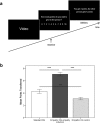Empathy promotes altruistic behavior in economic interactions
- PMID: 27578563
- PMCID: PMC5005993
- DOI: 10.1038/srep31961
Empathy promotes altruistic behavior in economic interactions
Abstract
What are the determinants of altruism? While economists assume that altruism is mainly driven by fairness norms, social psychologists consider empathy to be a key motivator for altruistic behavior. To unite these two theories, we conducted an experiment in which we compared behavior in a standard economic game that assesses altruism (the so-called Dictator Game) with a Dictator Game in which participants' behavioral choices were preceded either by an empathy induction or by a control condition without empathy induction. The results of this within-subject manipulation show that the empathy induction substantially increased altruistic behavior. Moreover, the increase in experienced empathy predicted over 40% of the increase in sharing behavior. These data extend standard economic theories that altruism is based on fairness considerations, by showing that empathic feelings can be a key motivator for altruistic behavior in economic interactions.
Figures


References
-
- United Nations High Commissioner for Refugees. Global Trends. UNHCR, Geneva, Switzerland (2014).
-
- Fehr E. & Fischbacher U.. The nature of human altruism. Nature 425, 785 (2003). - PubMed
-
- de Waal F. B.. Putting the Altruism Back into Altruism: The Evolution of Empathy. Annual Review of Psychology 59, 279 (2007). - PubMed
-
- Engel C.. Dictator games: a meta study. Experimental Economics 14, 583 (2011).
-
- Eisenberg N. & Miller P. A.. The relation of empathy to prosocial and related behaviors. Psychol Bull 101, 91 (1987). - PubMed
Publication types
LinkOut - more resources
Full Text Sources
Other Literature Sources

